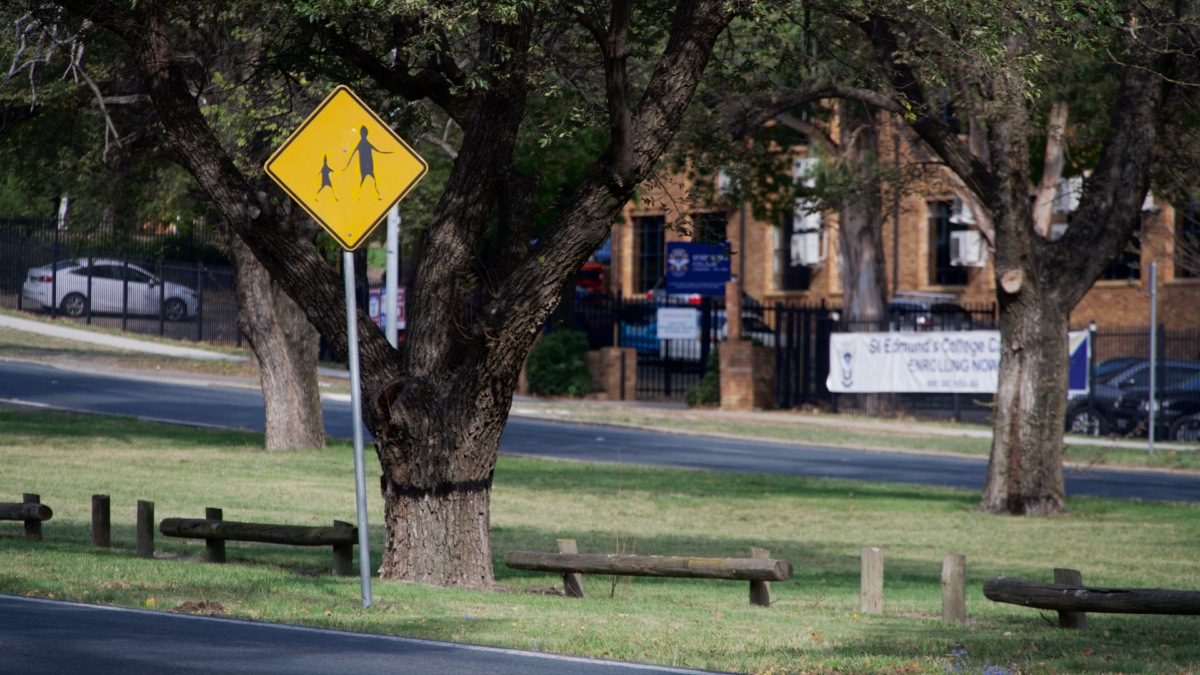Canberra Avenue, the road that runs from central Queanbeyan to Parliament House, has four lanes, a wide median strip, and measures about 45 meters wide from curb to curb. It has a speed limit of 60 kilometres per hour.
But, despite adjoining schools and homes, it has almost no signalised crossings for pedestrians between Manuka and the New South Wales border.
Even when people follow the road rules along Canberra Avenue, it is extremely dangerous, and people have known this for years. At my high school, St Edmund’s College, or Eddies, which is located at 110 Canberra Avenue, it was something of a villain.
When crossing the street around the Eddies campus, you are confronted with various dangers.
Cars are moving much faster than they would elsewhere.
Looking east (away from the City), the road goes up a slight gradient, blocking your view of traffic coming off a giant, fast-moving roundabout.
Looking west (towards the City), tree branches can block your view of traffic coming from the bottom of a hill.
Only recently did the government install a footpath across the median strip.
It is drilled into you by teachers very early on that you are to have absolutely nothing to do with this road.
If a teacher on bus stop duty spotted you trying to cross, they would warn you about how dangerous it is.
In a quote that has become a proverb, dating to the early 2010s, a senior teacher in the school is said to have yelled out, in his rather direct manner, to a student running across the road, “You’re a coward!”
In around Year 9 or 10, my Health and PE teacher, who went to the school himself, used a lesson on peer pressure to tell stories of classmates in Year 11 and 12 who got into horrific car accidents by speeding down Canberra Avenue on a dare after getting their P’s.
Horror stories and accosting aside, people do cross the street. People live there, of course, and even students who don’t have many reasons to. The R2 bus runs from Wentworth Avenue, near the train station. The nearest cafes for Year 11 and 12 students going to lunch or on their free period is on the other side of the street.
Sporadically, the school will lobby the government to implement measures to improve the street’s safety: sternly worded letters, petitions to the Legislative Assembly, and public appeals in the press.
These efforts are usually dismissed as, as transport minister Chris Steel put it in response to a petition launched in 2022, a reduced speed zone for the school and its traffic calming infrastructure would be “incompatible with this road’s arterial function”.
Minister Steel also promised an internal review investigating other potential safety measures, such as a signalised crossing, but it would not seem that much has changed.
The need to implement safety measures on Canberra Avenue takes on a whole new relevance as, last Friday, the worst nightmares of Eddies’ students, staff and alumni became a reality.
Police allege a man sped down Canberra Avenue from Queanbeyan before hitting two teenage students crossing outside Eddies.
I disagree with the ACT government that safety measures around the school would be incompatible with the arterial function of Canberra Avenue, not least because many arterial roads go even further than is usually proposed.
Sydney’s notorious Pennant Hills Road, perhaps the archetypal arterial road in Australia, has a school zone and even has traffic cameras that enforce it.
Canberra Avenue, at least outside Eddies, has neither.
Many arterial roads, even in Canberra, have frequent signalised pedestrian crossings. Literally the next road over, Wentworth Avenue, has such crossings!
Canberra Avenue has none (0) in the vicinity of the school: the nearest is over a kilometre — 1 thousand meters — away.
None of these measures would have prevented a person from acting in the manner police have alleged here: stealing a car and speeding it down a wide avenue.
However, they would certainly have decreased the likelihood that these two boys would have been injured by the alleged offender’s actions.
Imagine if, instead of running for their lives across the already extremely dangerous road, the boys were waiting for a green man at a traffic light.
Imagine if these boys could have jumped out of the way of the speeding green Commodore and in front of a car going slow enough that either it could have stopped or, at least, caused much less severe injuries.
These boys were not given these options.
Can we please talk about them?
Update: After this piece was written, the territory roads minister Tara Cheyne told a press conference that she had asked her directorate for “a briefing […on] any safety treatments that we might be able to implement” on Canberra Avenue.
We acknowledge the Ngunnawal and Ngambri people, who are the Traditional Custodians of the land on which Woroni, Woroni Radio and Woroni TV are created, edited, published, printed and distributed. We pay our respects to Elders past and present. We acknowledge that the name Woroni was taken from the Wadi Wadi Nation without permission, and we are striving to do better for future reconciliation.
